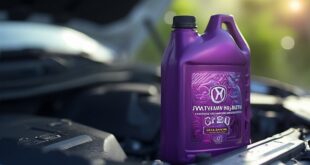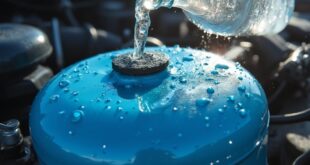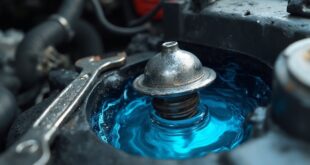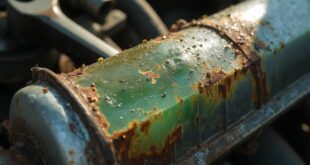To add antifreeze to your car safely, park on a flat surface and let the engine cool completely. Engage the parking brake, wear safety glasses and gloves, and gather a funnel. Check your coolant level against the minimum and maximum lines. Open the radiator cap carefully and pour in the antifreeze using the funnel. Once added, replace the cap securely. Regular maintenance is key, so keep an eye on your coolant levels to guarantee peak engine performance.
Understanding Antifreeze and Its Importance
While you might think of antifreeze as just another car fluid, it plays an essential role in keeping your engine running smoothly.
This coolant, typically a mix of water and either ethylene glycol or propylene glycol, prevents your engine from overheating and freezing. It also protects against corrosion and lubricates components like the water pump.
Most cars hold about 1.5 to 3 gallons of coolant, and various types are available, including conventional and organic acid technology.
Understanding antifreeze's importance guarantees your vehicle operates efficiently, helping you avoid costly repairs and prolonging your engine's lifespan.
Preparing Your Vehicle for Antifreeze Addition
Before adding antifreeze to your vehicle, make certain you take the necessary steps to prepare properly.
First, park on a flat, even surface to guarantee stability. Allow the engine to cool completely to avoid burns. Engage the parking brake and consider using wheel chocks for extra safety.
Gather your tools, including a funnel for precise pouring. Next, locate the coolant reservoir and check the antifreeze levels against the minimum and maximum lines.
If the level is low, you're ready to add antifreeze. Be mindful of the type of antifreeze you're using and whether it requires dilution.
Essential Safety Precautions to Follow
To guarantee your safety while adding antifreeze, it's crucial to take specific precautions before you begin.
First, engage the parking brake and consider using wheel chocks to prevent movement.
Make sure you're wearing safety glasses and gloves to protect against spills or splashes.
Avoid loose clothing that could get caught in the engine compartment.
Always let the engine cool completely before opening the coolant reservoir cap to prevent burns.
Finally, work in a well-ventilated area to avoid inhaling harmful fumes.
Following these steps will help guarantee a safe and effective antifreeze addition process.
Tools Needed for Adding Antifreeze
After ensuring your safety with the proper precautions, gather the tools necessary for adding antifreeze to your car.
You'll need a few essential items to make the process smooth and efficient:
- Funnel: This helps you pour antifreeze without spills, keeping your engine bay clean.
- Safety Glasses: Protect your eyes from splashes while working around the cooling system.
- Gloves: Wear these to shield your hands from chemicals and maintain hygiene.
Having these tools ready will make adding antifreeze quicker and safer, ensuring your vehicle runs efficiently and stays protected from temperature extremes.
Step-by-Step Guide to Adding Antifreeze
Having gathered your tools and guaranteed your safety, it's time to add antifreeze to your car. Start by parking on a flat surface and letting the engine cool completely. Locate the coolant reservoir and check the levels. Carefully remove the cap, and using a funnel, pour in the antifreeze until it reaches the appropriate line. Don't forget to secure the cap afterward!
| Step | Emotion |
|---|---|
| Check coolant levels | Anxiety |
| Pour antifreeze | Relief |
| Secure the cap | Accomplishment |
Your engine will thank you for it!
Maintaining Your Antifreeze Levels
Regular maintenance of your antifreeze levels is essential for keeping your engine running smoothly.
Here's how to stay on top of it:
- Check Monthly: Inspect your coolant levels every month or during oil changes. Add antifreeze if it's low.
- Flush Periodically: Flush your cooling system every 2-3 years to eliminate buildup and contaminants.
- Watch for Leaks: Regularly examine hoses and connections for leaks. Early detection can prevent serious engine damage.
Proper Disposal of Antifreeze and Environmental Considerations
While antifreeze is essential for your vehicle's performance, it's crucial to dispose of it properly to protect the environment.
Always check local regulations regarding antifreeze disposal, as improper disposal can lead to severe penalties. Many auto shops offer recycling services for used antifreeze, so take advantage of these options.
If you spill any antifreeze, clean it up immediately to prevent contamination. Consider using biodegradable antifreeze alternatives to lessen your environmental impact.
Frequently Asked Questions
Can I Use Any Type of Antifreeze in My Vehicle?
You can't use just any antifreeze in your vehicle. Different types have specific formulations. Always check your owner's manual for the recommended type to prevent potential engine damage and guarantee peak performance.
How Do I Know if My Antifreeze Is Contaminated?
To check if your antifreeze is contaminated, look for discoloration, debris, or an oily film. If you notice rust or a strange odor, it's best to flush and replace the coolant.
What Should I Do if I Accidentally Spill Antifreeze?
If you accidentally spill antifreeze, immediately clean it up using absorbent material. Dispose of it according to local regulations, and wash the area with soap and water to prevent toxicity and environmental harm.
How Often Should I Check My Antifreeze Levels?
You should check your antifreeze levels monthly or during oil changes. Keeping an eye on these levels helps prevent overheating and engine damage, ensuring your vehicle runs smoothly and efficiently throughout the year.
Is It Safe to Mix Different Antifreeze Types?
Mixing different antifreeze types isn't safe. They can contain incompatible additives that cause chemical reactions, leading to cooling system issues. Stick with the same type to maintain peak performance and prevent potential damage to your engine.
 Car Service Land Coupons for Oil change, Tires, Wheel alignment, Brakes, Maintenance
Car Service Land Coupons for Oil change, Tires, Wheel alignment, Brakes, Maintenance




